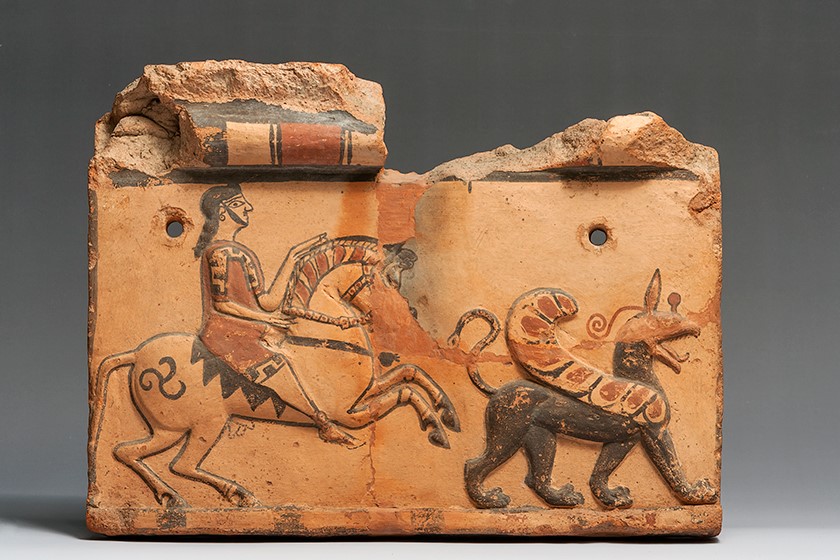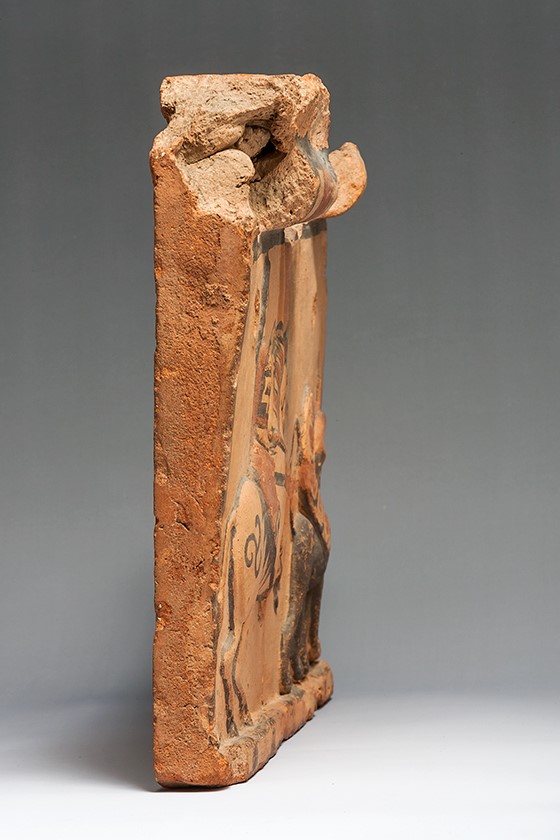Acquisition number: 1976.02
Reconstructed from three fragments without repainting. Orange-buff micaceous clay with white and some dark inclusions.
The scene is of a man riding right on a galloping horse and a griffin also moving right. The man carries no weapons and is probably not to be thought of as pursuing the creature. Dull red paint is used for his chiton and shoes, for stripes on the horse’s mane and dots on its harness; for the stripes on the griffin’s wing and for its face, tongue and ear, the knob on its head and the plume at the back. Black outline is used for the man, his horse, for the griffin’s wing, the end of its tail, its face and to pick out its upper teeth.
On the member below are alternate black and red vertical bands; above are squares of black and of red outlined with black; red on the broken member above. There are black borders at each side.
Title: Architectural Terracotta Plaque - 1976.02
Acquisition number: 1976.02
Author or editor: J.R. Green
Culture or period: Phrygian.
Date: Third quarter 6th century BC.
Material: Clay - Terracotta
Object type: Architectural features
Dimensions: 435mm (l) × 325mm (h)
Origin region or location: Türkiye
Origin city: Düver.
Display case or on loan: 3
Keywords: Phrygian, griffin, architectural, Pisidia
Sotheby (London), Sale Cat., 19 May 1975, no. 209, pl. XV; J.R. Green with B. Rawson, Catalogue of Antiquities in the Australian National University, A.N.U. (Canberra, 1981) 86-87; S. Buzzi, Die architektonischen Terrakotten aus Düverder Archäologischen Sammlung der Universität Zürich (Sammlungkataloge II, Zurich 1999) 98-99 (mention).
1976.02
Architectural Terracotta Plaque
Purchased. Length 43.5cm; ht 32.5cm; ht of frieze 23.5cm; max. depth of relief ca lcm.
Reconstructed from three fragments without repainting. Orange-buff micaceous clay with white and some dark inclusions.
The scene is of a man riding right on a galloping horse and a griffin also moving right. The man carries no weapons and is probably not to be thought of as pursuing the creature. Dull red paint is used for his chiton and shoes, for stripes on the horse’s mane and dots on its harness; for the stripes on the griffin’s wing and for its face, tongue and ear, the knob on its head and the plume at the back. Black outline is used for the man, his horse, for the griffin’s wing, the end of its tail, its face and to pick out its upper teeth.
On the member below are alternate black and red vertical bands; above are squares of black and of red outlined with black; red on the broken member above. There are black borders at each side.
The plaque is one of a series from a building in Düver, about 10 km east of Haçilar in Pisidia in modern Turkey (see Mellink, American Journal of Archaeology 68, 1964, 159). Other examples from the same series are in museums in Istanbul and Burdur in Turkey, in the Medelhavsmuseet in Stockholm, and in the Birmingham City Museum as well as a number of other collections. They were made as covering or protective plaques to be placed along the top of the wall of a building, presumably on a timber beam, immediately below the roof tiles (see the reconstruction). Note the two suspension holes in the upper part of the plaque. They are approximately 1.2cm in diameter and although they bear no trace of metal, the traces of the heads of the pegs hammered through them are quite clear, about 2.9cm in diameter.
One may also note that the plaque is deeper at the top than the bottom, so that if it were placed against a vertical surface or beam, the front face would have inclined down a little towards the viewer. Other possible reasons might have included protection from the weather or from the accumulation of dust.
The moulds for each of these figured plaques seem to have been much the same but the details of the painting differ. Some horses are black rather than white and there is a good deal of variation in the patterning of the griffin’s wings. See the centre plaque in the drawing (see images) which is taken from the article by N. Thomas, in Archaeological Reports 1964-65, 64-70.
The work is Phrygian under strong East Greek influence and probably belongs to the third quarter of the sixth century. There have been many publications and discussions of the plaques in this series; see in particular N. Thomas, Archaeological Reports 1964-65, 64-70; A. Greifenhagen, Archäologischer Anzeiger 1966, 44ff. (on a piece now in Berlin); P. Noelke in Antiken aus rheinischem Privatbesitz (Bonn 1973) no. 240, pl. 107 (with further references); M.E. Mayo, Arts in Virginia 21:2, 1981) 29-35; J.-L. Zimmermann, Collection de la Fondation Thétis (Geneva 1987) 38 no. 73 and 147 (ill.) (with refs., to which add The Jan Mitchell Gift to the Israel Museum [1974] 10 no. 1 [with colour plate], A. Dierichs, Das Bild des Greifen in der frühgriechischen Flächenkunst [Münster 1981] 194-195 nos OT 1-9 and 201-2, with figs. 93-95, and Bulletin Antieke Beschaving 57, 1982, 153-5 [F.L. Bastet]). For useful surveys which include parallel material, see A. Akerström, Die architektonischen Terrakotten Kleinasiens (Lund 1966), esp. 218-220; A. Ramage, Lydian Houses and Architectural Terracottas (Archaeological Exploration of Sardis 5, Cambridge Mass., 1978); N. Winter, Greek Architectural Terracottas from the Prehistoric Period to the End of the Archaic Period (Oxford 1993) esp. 234-254. S. Buzzi, Die architektonischen Terrakotten aus Düverder Archäologischen Sammlung der Universität Zürich (Sammlungkataloge II, Zurich 1999) 98-99 (mention) has full discussion and a good selection of key pieces.
On the Phrygian origins of plaques of this kind, see F. Isik, “Ein neuer Beleg zum phrygischen Ursprung der architektonischen Tonplatten”, Anadolu / Anatolia 34, 2008, 17-23 (with further bibl.).
On the motif, see C. Delplace, Le griffon de l’archaïsme à l’époque impériale (Brussels - Rome 1980) esp. 55-56, and the study by Dierichs mentioned above.
Sotheby (London), Sale Cat., 19 May 1975, no. 209, pl. XV; J.R. Green with B. Rawson, Catalogue of Antiquities in the Australian National University, A.N.U. (Canberra, 1981) 86-87; S. Buzzi, Die architektonischen Terrakotten aus Düverder Archäologischen Sammlung der Universität Zürich (Sammlungkataloge II, Zurich 1999) 98-99 (mention).


